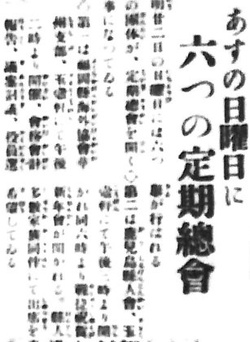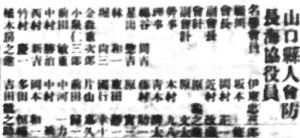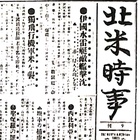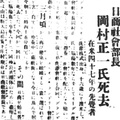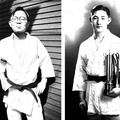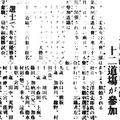The last chapter shared stories about the prosperity of the Nisei males’ judo. In this chapter, I would like to write about the prefectural associations (Kenjinkai) that played a big role in bringing Japanese residents in Seattle together.
To enhance the unity of those from the same prefecture in the Seattle Nikkei community, Hiroshima Kenjinkai was first established in 1901, followed by Tokushima Kenjinkai in 1902, Yamaguchi Kenjinkai in 1903, Ehime Kenjinkai in 1904, Kanagawa Kenjinkai in 1905, and many more that represented prefectures in other parts of Japan. In this chapter, I will focus on articles about Yamaguchi Prefecture, which is the home prefecture of my grandfather Yoemon.
Regular General Meetings of Kenjinkai
Every year, each Kenjinkai held a general meeting shortly after the New Year’s holidays. I found a number of articles1 announcing those meetings.
“Six General Meetings Will Be Scheduled on Sunday, Tomorrow” (January 21, 1939 issue)
On Sunday tomorrow, the 22nd, regular general meetings of six associations are scheduled. The first meeting will be the Washington State Branch of the Fukuoka Prefecture Overseas Association. It will be held at Gyokkoken from 2 p.m. The agenda includes reporting the finances, discussion of proposals, and the election of board members.
The second will be Kagoshima Kenjinkai, also at Gyokkoken, starting at 3 p.m., followed by a New Year celebration from 6 p.m. Many members are expected to attend with their family members.
The third will be the Certified Pike Place Japanese Agricultural Union, to be held at Kinkaro from 2 p.m., fostering friendship and hosting a New Year’s celebration.
The fourth will be the Yamaguchi Kenjinkai Bocho Overseas Association Branch, starting at 3:30 p.m. at Nikkoro, followed by a social gathering from 6 p.m. They expect the attendance of many young men and women.
The fifth will be the Washington State Shiga Kenjinkai, starting at 3 p.m. at Maneki-tei, followed by a social gathering.
The sixth will be the Seattle Branch of the Kumamoto Overseas Association, scheduled at Shinpu-ken from 6 p.m. They are hoping for the attendance of all members.
Introductions of Kenjinkai’s Presidents
I would like to share some articles about those who served as presidents of Kenjinkai. These articles were published in the column series titled “One Person a Day,” which I featured in Chapter 4 of this series—where they introduced notable people in Seattle from around 1919 with some humor.
President of the Kagoshima Kenjinkai Mr. Kanaya Okajima [Part 29] (February 15, 1919 issue)
Mr. Kanaya Okajima, who serves as the president of the Kagoshima Kenjinkai, holds a number of positions such as a committee member of the Nihonjinkai Immigration Bureau’s Correspondence and Communication and a director of the North American Nihonjinkai. His journey so far has been quite turbulent. He has attempted at starting a variety of businesses, yet none seem to have been successful.
Being a man who loves to work and does so with enthusiasm, his love for politics is greater than his love for eating. Having both strong obsessions and a fickle nature is something he’d probably want to work on. He seems, however, to have found some calmness recently with his irritability subsiding considerably.
President of the Hiroshima Kenjinkai Mr. Jiro Iwamura [Part 32] (February 22, 1919 issue)
Mr. Jiro Iwamura is the president of the Hiroshima Kenjinkai. As he is one of the oldest people in the Seattle community, his way of thinking seems quite old-fashioned. While being a former sergeant, once he feels tipsy, he starts quibbling and makes the simplest things difficult to understand . . . . He takes good care of others and work efficiently. He has been valued among his Hiroshima prefectural fellow.
I can say that with their unique personalities and leadership, both had passionate support from people from their home prefectures.
Yamaguchi Kenjinkai
“Regular General Meeting of the Yamaguchi Kenjinkai” (January 24, 1920 issue)
The Kenjinkai will hold their regular general meeting at Maneki from 7 p.m. on the 29th and discuss their establishment of the Bocho2 Overseas Association Branch. They encourage anyone, including non-members, to attend.
This “Bocho Overseas Association Branch” was established to unite with other Kenjinkai groups overseas and to further strengthen Kenjinkai. The Yamaguchi Kenjinkai, which was founded in 1903, was renamed as “Yamaguchi Kenjinkai Bocho Overseas Association Branch.”
“New Year’s Social Gathering of the Yamaguchi Kenjinkai” (January 8, 1940 issue)
The joint social gathering of the Yamaguchi Kenjinkai and the Junior Club took place at Gyokkoken last evening from 6 p.m. With Consul Sato and his wife and embassy clerk Ishide as guests, the event got quite lively with over 100 people in attendance. As part of entertainment, each member showed their hidden talent; and a movies was shown to the audiences. Making a peaceful mood, the party ended around 10:30 p.m. I’d like to note that the flower shop Cherryland sent a gift of a pot of gorgeous flowers.
Board Members of the Yamaguchi Kenjinkai
The names of board members of the Yamaguchi Kenjinkai Bocho Overseas Association were listed in the February 8, 1938, February 1, 1939, and January 26, 1940 issues. Chuzaburo Ito, who served as founding president of the Yamaguchi Kenjinkai, was given the title of honorary member around this time. Seiichi Okamura and Kaizo Chikamura were newly appointed as presidents. In the directors’ list in the 1938 issue, I found the name of Ryunosuke Yoshida, the father of Jim Yoshida who was good at judo.
Suekichi Miyato, who was from the Kaminoseki village, was also listed as a director in the 1939 and 1940 issues. He was the one who drove my grandfather Yoemon to the hospital when he got in an accident in December 1928. (For details please read Part 10 of “Yoemon Shinmasu – My Grandfather’s Life in Seattle.”)
Activities of the Yamaguchi Kenjinkai
“Yamaguchi Kenjin Calls for Relief Money” (August 12, 14, and 26, 1918 issues)
The Yamaguchi Kenjinkai has held a council meeting and decided to ask for relief money from its members in order to cover the damage from the storm and flooding, which hit Yamaguchi. They will send it as part of the disaster-relief fund. The estimated damage costs over 1.5 million yen.
In July 1918, Yamaguchi Prefecture was damaged by a severe flood caused by a fierce typhoon. To support the restoration, they asked its members in Seattle for relief money.
“A Lost Item at Yamaguchi Kenjinkai Picnic” (July 16, 1934 issue)
There was a small basket left at the venue of the Yamaguchi Kenjinkai picnic yesterday on July 15. Please contact Grand Union Laundry if you know anything.
Grand Union Laundry was run by Seiichi Okamura, who was president of the Yamaguchi Kenjinkai at the time.
“Yamaguchi Kenjinkai Calls for Consolation Money” (December 24, 1937 issue)
The Yamaguchi Kenjinkai Bocho Overseas Association Branch in Washington is asking for consolation money for families of military officials from Yamaguchi Prefecture who have gone to war. Yesterday they sent their first collection of 2,500 yen to the prefectural governor. They are still soliciting funds. It has been noted that Sumitomo Bank processed the transaction without charging the commission fee.
“Yamaguchi Kenjinkai Hosts Welcome Party for Trainees on Nihon-maru” (June 11, 1938 issue)
Tomorrow on June 12, the Yamaguchi Kenjinkai will have a social picnic with the trainees on Nihon-maru at Lincoln Parkfrom 11 a.m. and a welcome dinner party at Nikkoro from 6 p.m. They expect many members to come.
According to the June 10 issue, Nihon-maru, the navigation training ship of the Ministry of Education, brought 19 students to Seattle on the morning of June 10. The Kenjinkai of each of their home prefectures—Yamaguchi Prefecture, Hiroshima Prefecture, Kagoshima Prefecture, and Toyama Prefecture— held a welcome party on June 12 to foster friendship. The students in attendance of the party were allowed to stay at the venue until 10 p.m.
Activities of Yamaguchi Prefecture Junior Club
The Nisei whose parents were from Yamaguchi Prefecture founded the Yamaguchi Prefecture Junior Club. I found some articles that reported their various activities aimed at fostering friendship among those from Yamaguchi Prefecture.
“Yamaguchi Junior Picnic” (August 10, 1939 issue)
Due to the weather conditions and its inconvenience on the venue, Yamaguchi Prefecture Junior Club’s picnic had been postponed, and Sonita Beach was chosen as the venue this time. The event will be held on Sunday the 12th. To reach the venue, participants should take the 12th carriage to the terminal of Madison Street, and from there get to Kirkland by ferry. As they will be offered a car ride to the venue from there, many people are expected to attend. There will be a ferry at noon, 1:30, and 2:30. Participants should simply exchange their ticket they will receive in advance for a boarding ticket at the pier.
“Yamaguchi Junior Bazaar” (October 28, 1939 issue)
Yamaguchi Prefecture Junior Club will host a bazaar tomorrow from 10 a.m. to around 12:30 p.m. at Washington Hall; they expect the attendance of non-members, as they will prepare a feast that will contain sushi, ohagi (sweet rice balls with red bean pastes), udon, rice curry, hot dogs and others. There will be some dancing planned at night.
“Yamaguchi Junior News” (December 6, 1939 issue)
As decided at their last regular meeting this year, Yamaguchi Prefecture Junior Club donated 25 dollars to the Building Fund for Japanese American Citizens League Hall and 100 yen to the prefectural governor as the consolation money for families of military officials from Yamaguchi Prefecture. In addition, the pending Mothers’ Gathering will be held on the 10th from 6 p.m. at Gyokkoken, where they will invite mothers and have an appreciation party as well as to get them to exchange opinions. They have sent an invitation to each guest.
In the articles mentioned earlier, “New Year’s Social Gathering of the Yamaguchi Kenjinkai” and “New Board Members of Yamaguchi Kenjinkai” in the January 8, 1940 issue and the February 1, 1939 issue respectively, we find the reporting of the joint social gathering of the Kenjinkai and Nisei at Junior Club. This took place on January 22 of the same year.
*Excerpts from articles include summaries from the original text.
Note:
1. All article excerpts are from The North American Times unless noted otherwise.
2. Bocho was current Yamaguchi Prefecture.
*The English version of this series is a collaboration between Discover Nikkei and The North American Post, Seattle’s bilingual community newspaper. This article was originally publishd in Japanese on October 31, 2022 in The North American Post.
© 2022 Ikuo Shinmasu


